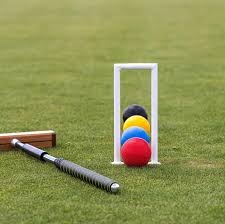Croquet: A Gentleman's Game of Strategy and Precision

Croquet: A Gentleman's Game of Strategy and Precision
Croquet, often associated with manicured lawns, leisurely afternoons, and refined elegance, is a sport that combines skill, strategy, and camaraderie. Originating in the 19th century and enjoyed by enthusiasts around the world, croquet has evolved from a pastime of the aristocracy to a competitive sport that challenges players of all ages and backgrounds.
Origins and History
The origins of croquet can be traced back to 19th-century England, where it emerged as a variation of earlier lawn games. Its popularity soared among the Victorian upper class, who relished its blend of outdoor recreation and social interaction. The game's formal rules were codified in the 1860s, laying the foundation for structured gameplay and organized tournaments.
Gameplay and Equipment
Croquet is played on a rectangular lawn, known as a court, divided into a series of boundaries and hoops (also called wickets). Players use mallets to strike wooden or plastic balls through the hoops in a specific sequence, aiming to complete the course in the fewest number of strokes. Each player or team alternates turns, strategizing to outmaneuver opponents while maintaining precise control over ball placement and direction.
Key Equipment:
- Mallets: Used to strike the balls, mallets vary in size and weight depending on player preference and skill level.
- Balls: Typically four balls in croquet—blue, red, black, and yellow—each assigned to a player or team.
- Hoops (Wickets): Strategically placed on the court, players must pass their ball through the hoops in a prescribed order to advance and score points.
- Stakes: The final objective of the game is to hit the stake or peg positioned at the center of the court after navigating through all hoops, completing the course.
Strategy and Skills
Croquet demands a combination of finesse, strategy, and tactical thinking. Players must carefully plan each shot to position their ball advantageously for subsequent turns while impeding opponents' progress. Skills such as ball placement, hoop negotiation, and defensive play are crucial, requiring both precision and adaptability to navigate the course effectively.
Competitive and Social Aspects
While croquet is renowned for its leisurely pace and etiquette, competitive tournaments and leagues exist worldwide, attracting skilled players eager to showcase their prowess. Major championships, including the World Croquet Federation's World Championship and regional events like the British Open, offer opportunities for players to compete at the highest levels and earn recognition within the croquet community.
Beyond competition, croquet fosters a sense of camaraderie and social interaction among participants. Clubs and organizations host regular gatherings and social events where players of all skill levels can enjoy friendly matches, share strategies, and appreciate the game's rich traditions and heritage.
Enduring Appeal and Legacy
The enduring appeal of croquet lies in its accessibility and versatility. Suitable for players of varying ages and physical abilities, croquet encourages participation from families, friends, and communities seeking outdoor recreation and friendly competition. Its emphasis on strategy, skill development, and sportsmanship ensures that each game is not only enjoyable but also intellectually stimulating and socially enriching.
Conclusion
Croquet continues to enchant players and spectators alike with its blend of strategic gameplay, genteel ambiance, and timeless appeal. Whether enjoyed casually on a backyard lawn or competitively in international tournaments, croquet remains a cherished pastime that celebrates tradition, skill, and the joy of outdoor recreation. As enthusiasts worldwide embrace its heritage and embrace its challenges, croquet's legacy as a gentleman's game of precision and strategy endures, inspiring new generations to appreciate its unique charm and enduring allure.
- Arts
- Business
- Computers
- Jocuri
- Health
- Home
- Kids and Teens
- Money
- News
- Recreation
- Reference
- Regional
- Science
- Shopping
- Society
- Sports
- Бизнес
- Деньги
- Дом
- Досуг
- Здоровье
- Игры
- Искусство
- Источники информации
- Компьютеры
- Наука
- Новости и СМИ
- Общество
- Покупки
- Спорт
- Страны и регионы
- World


